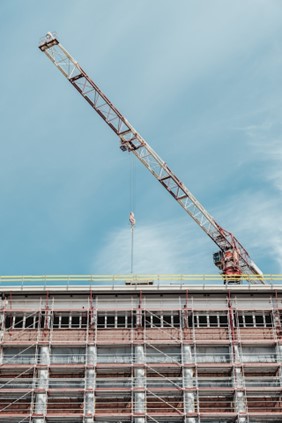
Large-scale infrastructure projects are crucial for the growth and development of cities, regions, and nations. These projects often involve transportation networks, bridges, water systems, electrical grids, and urban development initiatives that not only serve the public good but also stimulate the economy. Real estate development firms play an essential role in these projects, contributing to urban growth and revitalization.
This article explores the key challenges faced in development projects, providing best practices to overcome these challenges, ensuring timely completion, within-budget delivery, and long-term sustainability.
Affirmative Development
Ensuring economic inclusivity and diversity has become a critical factor in shaping sustainable urban growth, particularly for minority- and women-owned businesses (MWBEs). The Peebles Corporation, a 100% minority-owned firm, champions this mission through its Affirmative Development™ approach—an innovative model that leverages real estate projects as catalysts for economic opportunity. Unlike traditional development strategies, Affirmative Development™ prioritizes diversity, equity, and inclusion by actively breaking down barriers for underrepresented businesses in the industry.
A key component of this approach is the commitment to MWBE participation, with a company-wide target of ensuring that at least 30% of all project contracts are awarded to MWBEs. This initiative fosters economic mobility by providing these businesses with direct access to major development projects, increasing their visibility and strengthening their long-term success. By integrating inclusive hiring practices, diverse partnerships, and community-driven initiatives, Peebles Corporation not only promotes sustainable urban growth but also ensures that the economic benefits of large-scale developments are distributed equitably among local businesses and communities.
This model serves as a blueprint for the real estate industry, demonstrating how developers can merge profitability with social responsibility. Through Affirmative Development™, Peebles Corporation continues to lead by example, proving that prioritizing MWBE inclusion is not just an ethical responsibility but a powerful strategy for driving economic progress, fostering innovation, and creating lasting social impact in urban development.
Budget Overruns and Cost Control
One of the most persistent challenges in construction projects is cost overruns. Managing the budget can be complex due to various unforeseen factors such as inflation, fluctuating material prices, and unforeseen site conditions. A lack of accurate cost estimation at the planning stage can result in higher-than-expected expenses, leaving projects struggling to stay within financial constraints.
To prevent cost overruns, it's crucial to have thorough financial planning at the outset. This includes considering all possible costs, including labor, materials, equipment, and permits, as well as establishing contingency funds to account for unexpected costs. Additionally, ongoing monitoring of the project budget allows for adjustments as needed. Leveraging advanced project management software can help keep track of expenses in real time, enabling project managers to address potential issues before they spiral out of control.
Delays and Time Management
Time management is another critical challenge. Development projects often face delays due to various reasons, including weather conditions, labor shortages, supply chain disruptions, and even political or regulatory challenges. These delays not only increase costs but can also affect public perception, stakeholder confidence, and project financing.
Successful time management requires a clear and realistic timeline from the start. It’s essential to allocate buffers for potential delays and ensure that there is flexibility built into the schedule. Additionally, using modern project management techniques can help teams focus on essential tasks and prioritize resources to meet deadlines. A strong communication plan and regular updates ensure that all stakeholders are aligned and informed about progress and setbacks.
Regulatory and Environmental Compliance
Building projects are subject to strict regulatory standards, environmental laws, and safety protocols, which can vary significantly depending on location. For instance, commercial development companies often face challenges when building near protected ecosystems, dealing with historic preservation requirements, or complying with local zoning laws. Failure to adhere to these regulations can lead to delays or even halt the project altogether.
To address these challenges, it’s important for building firms to conduct a thorough environmental and regulatory assessment before beginning construction. This involves reviewing local laws, obtaining the necessary permits, and consulting with environmental experts to minimize the project’s carbon footprint and environmental impact. Many successful projects involve community engagement from the start to ensure that local concerns are addressed and to gain support for the development.
Project Scope Creep
Scope creep refers to the gradual expansion of a project’s objectives without adjusting time or budget expectations. This often happens when stakeholders request additional features or changes during construction. These changes may seem small at first but can lead to significant delays and budget increases as the project expands beyond the original vision.
To avoid scope creep, it’s important to establish a clear scope at the outset and have all stakeholders agree to it. This should be documented in a project charter that outlines all goals, objectives, deliverables, and timelines. During the execution, any requests for changes should be carefully evaluated for their impact on time, cost, and resources, and approvals should be obtained before proceeding.
Labor and Resource Management
Managing labor resources and ensuring the availability of skilled workers is a constant challenge. Labor shortages, strikes, or even worker turnover can cause delays or force the project team to adjust to new conditions mid-project.
Additionally, securing high-quality materials and equipment in a timely manner is often a challenge, especially when dealing with international suppliers or when a project depends on specialized materials that must be sourced from specific locations.
Effective Labor and Resource Management
Fostering strong relationships with suppliers and contractors can help ensure that materials are delivered on time. Additionally, maintaining a skilled workforce is essential. It’s crucial for development firms to invest in worker training programs, as well as in the development of partnerships with local or regional labor sources, which can reduce risks associated with labor shortages. Using resource management tools that track labor availability, material needs, and equipment use can help ensure efficient utilization of resources.
Best Practices

Early and Comprehensive Planning
Planning is the foundation of any successful infrastructure project. Starting with a detailed feasibility study, the project should outline the goals, scope, timeline, resources, and potential risks involved. Land development companies, in particular, must carefully assess site conditions and potential challenges related to zoning, environmental concerns, and access.
Best practices include conducting thorough risk assessments and establishing contingency plans to address potential issues during construction. Early-stage planning should also involve community engagement, where developers can address public concerns and set clear expectations about the project’s impact on the surrounding area.
Collaboration and Communication
Effective communication among all parties involved is vital for a project’s success. This includes everyone from government agencies, contractors, and subcontractors to investors and the local community. Regular updates, clear lines of communication, and collaborative project management tools can ensure everyone is on the same page.
Embrace Innovation and Technology
Technology is changing the landscape of infrastructure projects. From building information modeling (BIM) to drones for surveying, and 3D printing for building components, these innovations can streamline the construction process, reduce errors, and lower costs.
Incorporating advanced construction technologies such as smart sensors to monitor structural integrity and AI-driven project management software can also improve decision-making and speed up processes. By adopting these technologies early on, developers can increase productivity and manage resources more effectively.
Focus on Sustainability
Sustainability is an increasingly important factor in modern real estate projects. It’s no longer just about building; it’s about building smart, green, and sustainable structures that are both energy-efficient and environmentally responsible.
Incorporating sustainable practices into infrastructure projects involves:
- Using green building materials
- Implementing energy-efficient technologies
- Designing eco-friendly buildings
- Managing water usage efficiently
Focusing on sustainability not only benefits the environment but can also reduce long-term operating costs and attract eco-conscious investors and clients.
Continuous Monitoring and Adaptation
Monitoring the progress of development projects should never stop. Best practices include project health checks at every stage of the project—this includes reviewing costs, timelines, quality standards, and safety protocols. When necessary, make adjustments to ensure that the project remains on track, both in terms of budget and timeline.
Conclusion
Urban development and real estate present unique challenges but offer significant rewards when executed properly. The key to success lies in early planning, effective communication, embracing innovative technologies, and maintaining a focus on sustainability. By identifying potential risks early on and fostering collaboration among stakeholders, project leaders can overcome obstacles and keep the project moving forward.
By adhering to best practices, these projects can be completed on time and within budget, while also ensuring long-term growth and success in urban areas.
Through continuous monitoring, strong leadership, and thoughtful planning, large-scale infrastructure and urban development projects can not only meet immediate goals but also deliver lasting benefits to communities, businesses, and the broader economy, shaping vibrant, sustainable urban environments for years to come.

No comments.